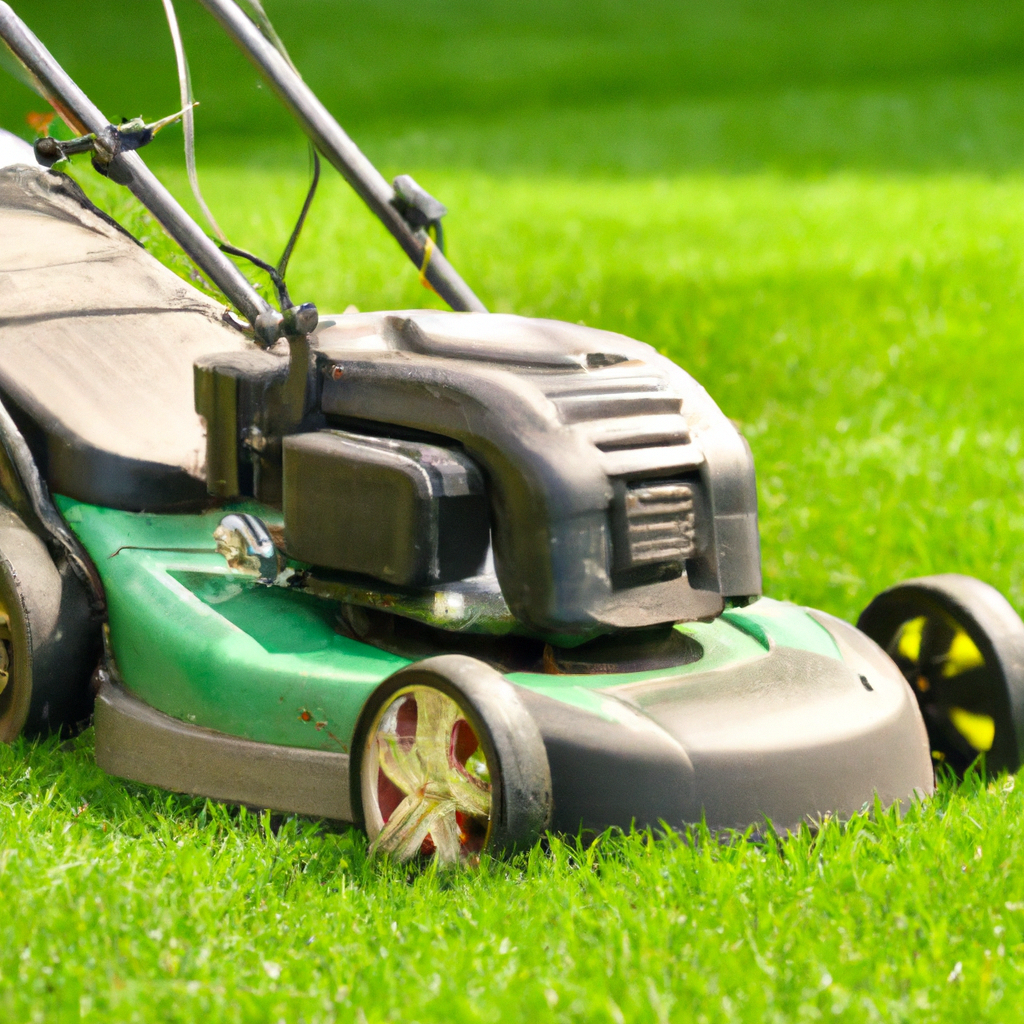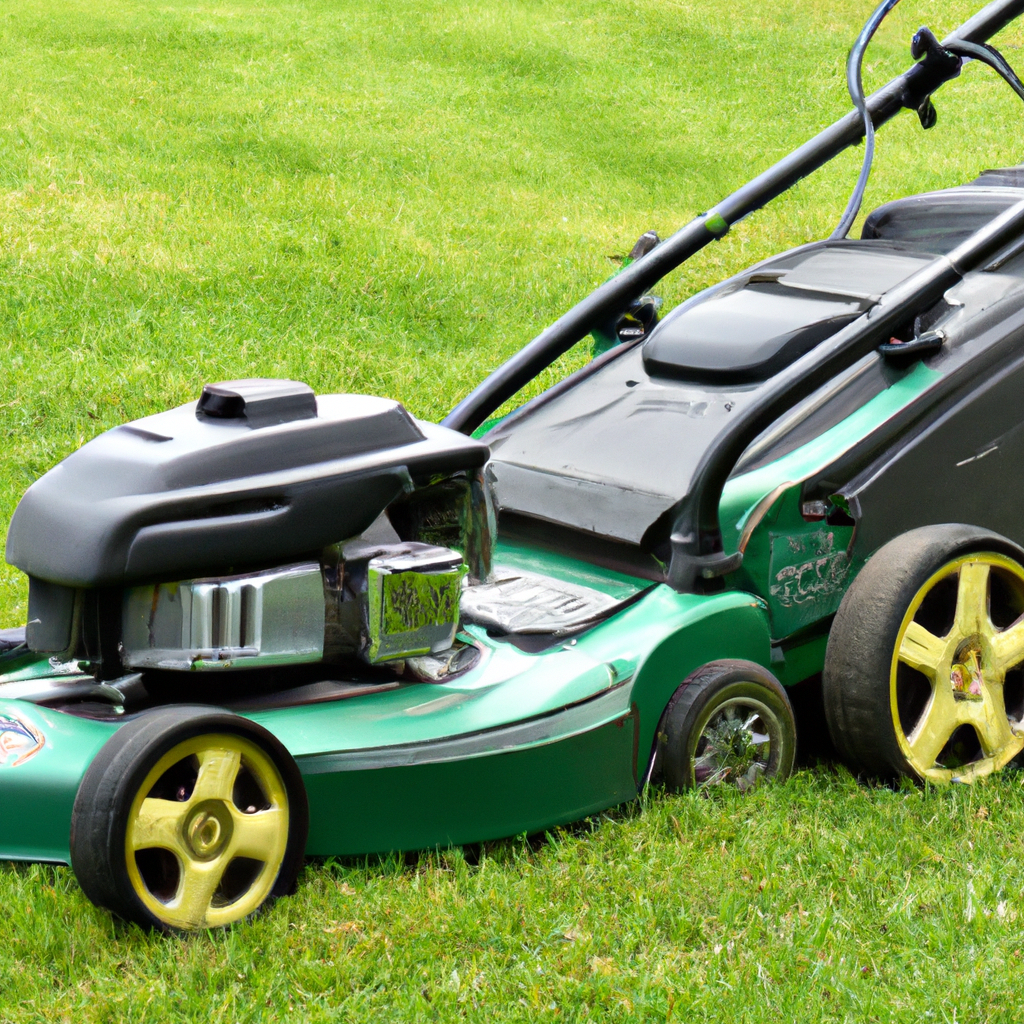Keeping your lawn looking pristine and well-maintained can be a daunting task, especially for busy homeowners with a never-ending to-do list. Thankfully, mastering lawn care doesn’t have to be overwhelming. In this article, you will discover some time-saving tips that will help you effortlessly maintain a beautiful and healthy lawn, allowing you to enjoy your outdoor oasis without sacrificing precious free time. Say goodbye to hours spent on yard work and hello to a perfectly manicured lawn with these simple yet effective strategies.
Choosing the Right Equipment
Invest in a quality lawn mower
When it comes to maintaining a beautiful and well-kept lawn, one of the first things you need to consider is investing in a quality lawn mower. There are several types of lawn mowers available on the market, including push mowers and riding mowers. Consider the size of your lawn and your personal preferences to choose the right one for you. A quality lawn mower will not only make the task of mowing your lawn easier and more efficient but will also ensure a cleaner and more even cut.
Consider a trimmer or edger for precise work
In addition to a lawn mower, it is also worth considering investing in a trimmer or edger for more precise work. Trimmers and edgers allow you to tidy up the edges of your lawn, pathways, and flowerbeds with precision. They can help you achieve that polished and professional look that sets your lawn apart from the rest. With the right trimmer or edger, you can easily maintain those hard-to-reach areas and ensure a neat and tidy finish.
Choose a rake suitable for your lawn type
When it comes to keeping your lawn looking its best, raking is an essential task. However, not all rakes are created equal, and it’s important to choose one that is suitable for your lawn type. If you have a large lawn with thick grass, a garden rake with flat, sturdy tines will work well. On the other hand, if you have a smaller lawn or one with more delicate grass, a leaf rake with flexible tines will be more appropriate. Choosing the right rake will make the task of raking leaves and debris much easier and more efficient.
Select the right spreader for efficient fertilization
Fertilizing your lawn is crucial for maintaining its health and promoting lush growth. To ensure efficient fertilization, it is important to select the right spreader for the job. Drop spreaders are ideal for smaller lawns or areas that require precise application, as they deposit the fertilizer directly onto the grass. Broadcast spreaders, on the other hand, are better suited for larger lawns or areas that need even coverage. By choosing the right spreader, you can achieve a more effective and uniform distribution of fertilizer, leading to a healthier and greener lawn.
Creating a Time-Saving Lawn Care Schedule
Determine the ideal mowing frequency
One of the keys to maintaining a beautiful lawn is mowing it at the right frequency. The ideal mowing frequency depends on several factors, such as the type of grass, climate, and season. Generally, it is recommended to mow your lawn once a week during the peak growing season and adjust the frequency accordingly during slower periods. By determining the ideal mowing frequency for your lawn, you can ensure that it always looks neat and well-manicured while saving time and energy.
Allocate specific days for different tasks
To streamline your lawn care routine and maximize efficiency, it is helpful to allocate specific days for different tasks. For example, you could designate one day for mowing, another for trimming and edging, and another for fertilizing or aerating. By creating a schedule and sticking to it, you can avoid wasting time and avoid feeling overwhelmed by the numerous tasks involved in lawn care.
Organize tasks based on priority
Prioritizing tasks is key to efficient lawn care. Begin by identifying the most important tasks that need to be done regularly, such as mowing and watering, and then allocate time for other tasks accordingly. It’s also important to take into account the specific needs of your lawn, such as any ongoing weed control or pest management. By organizing tasks based on priority, you can ensure that you are spending your time and effort on the most crucial tasks, ultimately saving time in the long run.
Utilize automation tools for irrigation
Watering your lawn is a crucial aspect of lawn care, but it can also be a time-consuming task. To save time and make watering more efficient, consider utilizing automation tools such as programmable irrigation systems. These systems allow you to set specific schedules and durations for watering, ensuring that your lawn receives adequate moisture without you having to manually water it every day. By automating your irrigation, you can free up time to focus on other important tasks, while still ensuring your lawn remains healthy and well-hydrated.

Efficient Mowing Techniques
Follow the one-third rule for grass length
When mowing your lawn, it is important to follow the one-third rule for grass length. This means that you should never cut more than one-third of the grass blades’ height in a single mowing session. Cutting too much of the grass at once can stress the plants and leave your lawn vulnerable to damage and disease. By adhering to the one-third rule, you can maintain a healthier lawn and minimize the need for extensive maintenance and repair.
Use a pattern to ensure even cutting
To achieve an even and professional-looking lawn, it is important to use a mowing pattern when cutting the grass. This involves mowing in a different direction each time you mow, such as north-south, then east-west, and so on. By using a pattern, you can prevent the grass from being pushed down in one direction, resulting in an uneven cut. Additionally, alternating patterns can help prevent soil compaction and encourage healthier growth.
Mow when the grass is dry
Mowing your lawn when the grass is dry is not only more pleasant for you but also better for the health of your lawn. Wet grass can clog the mower blades, resulting in an uneven cut and potential damage to the grass. It is recommended to wait until the morning dew has dried or mow in the late afternoon when the grass has had a chance to dry out. By mowing when the grass is dry, you can ensure a cleaner cut and minimize the risk of stress or disease.
Employ a mulching mower for natural fertilization
If you want to save time and improve the overall health of your lawn, consider using a mulching mower. Mulching mowers are designed to cut the grass into fine clippings, which are then returned to the lawn. These clippings act as a natural fertilizer, providing essential nutrients and organic matter to the soil. Not only does this eliminate the need for raking and bagging, but it also promotes healthier and greener growth. By employing a mulching mower, you can save time while enhancing the fertility of your lawn.
Streamlining Watering Practices
Water deeply but less frequently
When it comes to watering your lawn, the key is to water deeply but less frequently. Shallow and frequent watering can lead to shallow root growth and make your lawn more susceptible to drought and stress. Instead, give your lawn a good soaking once or twice a week, depending on the climate and season. This allows the water to penetrate deeper into the soil, encouraging the roots to grow deeper as well. By watering deeply but less frequently, you can save time and ensure a healthier and more resilient lawn.
Install a programmable irrigation system
To further streamline your watering practices and save time, consider installing a programmable irrigation system. These systems allow you to set specific schedules and durations for watering, taking into account factors such as the weather and the specific needs of your lawn. With a programmable irrigation system, you can automate the entire watering process, ensuring that your lawn receives the right amount of water at the right time. This not only saves you time and effort but also helps conserve water by avoiding overwatering.
Monitor the weather conditions
Monitoring the weather conditions is essential for efficient watering practices. By keeping an eye on the forecast, you can adjust your watering schedule accordingly. If rain is in the forecast, you can skip a watering session and take advantage of nature’s free water. On the other hand, if a dry spell is expected, you can plan to water your lawn accordingly. By paying attention to the weather conditions, you can optimize your watering practices and avoid wasting time and water.
Consider using rainwater or greywater
Another time-saving and environmentally friendly option for watering your lawn is to consider using rainwater or greywater. Rain barrels or other rainwater collection systems can be installed to capture and store rainwater, which can then be used to water your lawn. Similarly, greywater, which is water from sources such as sinks, showers, or laundry, can be reused for irrigation purposes. By utilizing these alternative water sources, you can save time and reduce your reliance on the municipal water supply.

Smart Weed and Pest Control
Implement preventive measures
Prevention is key when it comes to weed and pest control. By implementing preventive measures, you can minimize the need for extensive treatments and save time in the long run. Regularly inspect your lawn for signs of weeds or pests and take action before they become a major problem. This can include practices such as maintaining healthy soil, proper lawn care, and removing weeds as soon as they appear. By being proactive and vigilant, you can prevent weeds and pests from taking hold and save yourself the hassle of more intensive treatments.
Use natural or organic weed control methods
If weeds do become a problem in your lawn, consider using natural or organic weed control methods. These methods are not only effective but also safer for the environment, your family, and your pets. Options such as manual weed removal, vinegar-based herbicides, or corn gluten meal can be utilized to target and eliminate weeds without the use of harsh chemicals. By opting for natural or organic weed control methods, you can save time while maintaining an eco-friendly lawn.
Identify and treat specific lawn pests
Just like weeds, lawn pests can wreak havoc on your lawn if left untreated. It is important to identify the specific pests that are causing damage to your lawn and treat them accordingly. Whether it’s grubs, chinch bugs, or armyworms, there are specific methods and products available to combat each type of pest. By accurately identifying the pest and using targeted treatments, you can effectively eliminate the cause of damage and restore your lawn to its healthy state.
Consider professional services for complex issues
In some cases, lawn care issues may be too complex or time-consuming to handle on your own. If you find yourself struggling to control weeds or pests despite your best efforts, it may be worth considering professional lawn care services. Lawn care professionals have the expertise, experience, and specialized equipment to tackle even the most challenging issues. By enlisting their help, you can save time and ensure that your lawn receives the necessary care and treatments it needs to thrive.
Efficient Fertilization Strategies
Test the soil to determine nutrient needs
Before applying any fertilizer, it is crucial to test your soil to determine its nutrient needs. A soil test will provide you with valuable information about the pH level, nutrient deficiencies, and other factors that impact the health of your lawn. Armed with this knowledge, you can choose the right type and amount of fertilizer to address any deficiencies and promote optimal growth. By testing the soil and targeting your fertilization efforts, you can save time and money by avoiding unnecessary or ineffective applications.
Choose slow-release or controlled-release fertilizers
When selecting a fertilizer for your lawn, consider opting for slow-release or controlled-release formulations. These types of fertilizers gradually release nutrients over an extended period, providing a steady and consistent supply to your lawn. This not only reduces the need for frequent applications but also minimizes the risk of nutrient runoff and leaching, which can harm the environment. By choosing slow-release or controlled-release fertilizers, you can save time and ensure the long-term health and vitality of your lawn.
Use a spreader for even application
To achieve an even and uniform distribution of fertilizer, it is important to use a spreader. A spreader allows you to apply the fertilizer evenly across your lawn, eliminating streaks or patches of over or under-fertilization. Whether you choose a drop spreader or a broadcast spreader will depend on the size of your lawn and your personal preferences. By using a spreader, you can save time and ensure that your fertilizer is applied efficiently and effectively.
Consider organic alternatives
If you prefer to take an organic approach to lawn care, there are plenty of organic fertilizers available on the market. Organic fertilizers are derived from natural sources and provide essential nutrients to your lawn without the use of synthetic chemicals. They are safe for the environment, your pets, and your family. Additionally, organic fertilizers often help improve the soil structure and microbial activity, leading to healthier and more resilient lawns. By considering organic alternatives, you can save time while maintaining a sustainable and eco-friendly lawn.

Aeration and Overseeding
Understand the benefits of aeration
Aeration is a process that involves creating small holes in the soil to improve air circulation, water penetration, and nutrient absorption. By aerating your lawn, you can alleviate soil compaction and promote a healthier root system. This results in improved overall lawn health and enhanced growth. Aeration can be particularly beneficial for lawns that experience heavy foot traffic or have a lot of clay or compacted soil. By understanding the benefits of aeration, you can save time and invest in the long-term health of your lawn.
Select the appropriate time for aeration
Timing is crucial when it comes to aeration. The best time to aerate your lawn is during the growing season when the grass is actively growing. For cool-season grasses, such as Kentucky bluegrass or fescue, early fall or early spring is ideal. For warm-season grasses, such as Bermuda grass or St. Augustine grass, late spring or early summer is the recommended time. By aerating at the appropriate time, you can maximize the benefits and ensure optimal results.
Follow the correct overseeding techniques
Overseeding is the process of sowing grass seed over an existing lawn to fill in thin or bare areas and improve overall density. It is an effective way to rejuvenate your lawn and promote healthy and lush growth. When overseeding, it is important to follow the correct techniques to ensure success. This includes proper soil preparation, selecting the right grass seed for your lawn type, and ensuring good seed-to-soil contact. By following the correct overseeding techniques, you can save time and achieve a denser and more vibrant lawn.
Utilize a power rake or core aerator
To streamline the process of aeration and overseeding, consider utilizing a power rake or core aerator. A power rake, also known as a dethatcher, removes debris and dead grass from the surface of your lawn, allowing for better seed penetration and seed-soil contact. A core aerator removes plugs of soil from the lawn, creating the necessary holes for improved air, water, and nutrient circulation. By using these specialized tools, you can save time and ensure more effective aeration and overseeding results.
Maintaining Healthy Edges and Borders
Regularly trim and neaten edges
To maintain a well-groomed and professional-looking lawn, it is important to regularly trim and neaten the edges. This includes trimming along the borders of your lawn, pathways, flowerbeds, and any other areas where the grass meets a different surface. By keeping the edges neat and tidy, you can enhance the overall appearance of your lawn and create a clean and defined look.
Consider using edging materials for definition
For a more permanent and defined look, consider using edging materials. Edging materials such as plastic, metal, or stone can be installed along the borders of your lawn to create clear and distinct boundaries. Not only do these materials provide a clean and polished finish, but they also help prevent grass from encroaching into flowerbeds or other areas. By using edging materials, you can save time on frequent trimming and ensure that your lawn maintains its neat and well-defined edges.
Use a spade to create clean borders
If you prefer a more natural and organic edge to your lawn, you can create clean borders using a spade. A sharp spade can be used to cut straight edges or gentle curves along the borders of your lawn. This method requires occasional maintenance to keep the edges sharp and defined but can be a cost-effective and visually appealing alternative to using edging materials. By using a spade to create clean borders, you can save time and achieve a more rustic and natural look for your lawn.
Control weeds along edges
Edges and borders are often prime locations for weed growth. To maintain neat and weed-free edges, it is important to control weeds effectively. This can include regularly pulling out weeds by hand, using natural or organic weed control methods, or applying targeted weed killers. By staying on top of weed control along the edges of your lawn, you can save time in the long run and ensure that your lawn maintains its clean and polished appearance.

Proper Leaf Management
Rake leaves regularly to prevent suffocation
One of the most important tasks in lawn care during the fall season is the regular removal of fallen leaves. Leaves can suffocate the grass, block sunlight, and create a moist environment that is conducive to disease and pest problems. By raking leaves regularly, you can prevent these issues and maintain the health and appearance of your lawn. Use a quality rake suitable for your lawn type and remove leaves promptly to avoid any negative impact on your grass.
Utilize a leaf blower or vacuum for efficiency
If you have a large lawn or a significant amount of leaves to deal with, using a leaf blower or vacuum can greatly streamline the process. Leaf blowers and vacuums allow you to quickly and efficiently gather and remove leaves from your lawn. They can save you significant time and effort compared to manual raking. Consider investing in a high-quality leaf blower or vacuum that suits your specific needs and enjoy a more efficient leaf removal process.
Consider composting or mulching leaves
Instead of disposing of your leaves, consider composting or mulching them. Composting leaves can provide you with nutrient-rich compost that can be used to enrich your soil and nourish your plants. Mulching leaves involves using a mulching mower to finely chop the leaves and spread them back onto the lawn as a natural mulch. Both methods not only save time and effort but also promote sustainability and provide added benefits to your lawn and garden.
Use fallen leaves for natural mulch
Another way to make use of fallen leaves is to use them as natural mulch for your flowerbeds, gardens, or around trees and shrubs. Fallen leaves act as a protective layer, helping to retain moisture, suppress weeds, and improve soil health. Instead of spending time and money on store-bought mulch, utilize fallen leaves from your lawn and enjoy the many benefits they provide. By using fallen leaves as natural mulch, you can save time, money, and resources.
Efficient Storage and Maintenance
Clean and store equipment properly
Proper storage and maintenance of your lawn care equipment contribute to their longevity and efficiency. After each use, take the time to clean your equipment, removing any grass clippings, dirt, or debris. This not only ensures that your equipment works properly but also prevents the spread of diseases or pests across your lawn. Additionally, store your equipment in a dry and secure location to protect it from the elements and potential theft. By incorporating proper cleaning and storage practices, you can extend the lifespan of your equipment and save time on repairs or replacements.
Sharpen mower blades regularly
Sharp mower blades are essential for achieving a clean and precise cut. Dull blades can tear the grass instead of cutting it cleanly, resulting in frayed and unhealthy-looking grass. Regularly inspect and sharpen your mower blades to ensure optimal performance. If you are not comfortable sharpening the blades yourself, consider taking them to a professional for maintenance. By keeping your mower blades sharp, you can save time and achieve a more professional-looking lawn.
Regularly inspect and maintain machinery
Regular inspection and maintenance of your lawn care machinery are crucial for its proper functioning. Inspect your equipment regularly for any signs of damage, wear, or malfunction. Check the oil levels, filters, belts, and other parts to ensure that everything is in good working condition. Follow the manufacturer’s recommendations for maintenance and servicing, including oil changes, filter replacements, and other routine tasks. By staying on top of maintenance, you can avoid costly breakdowns and ensure that your equipment operates efficiently.
Organize tools for easy accessibility
To save time and streamline your lawn care routine, it is helpful to keep your tools and equipment organized and easily accessible. Invest in a tool storage system or create a designated space in your garage or shed to store your equipment. Use hooks, shelves, or pegboards to keep everything in order and within reach. This way, you can easily find the tools you need when you need them, minimizing the time spent searching and maximizing your productivity.
In conclusion, maintaining a beautiful and well-kept lawn doesn’t have to be a time-consuming task. By choosing the right equipment, creating a time-saving lawn care schedule, employing efficient techniques, streamlining watering practices, implementing smart weed and pest control, utilizing efficient fertilization strategies, practicing aeration and overseeding, maintaining healthy edges and borders, managing leaves properly, and ensuring efficient storage and maintenance, you can achieve a manicured and healthy lawn while saving time and effort. With the right approach and a little planning, master lawn care can be made easy even for busy homeowners. Time-saving tips combined with efficient practices can transform your lawn into a source of pride and enjoyment, allowing you to make the most of your outdoor space without feeling overwhelmed by the tasks at hand. So get started on your lawn care journey and enjoy the rewards of a beautiful and well-maintained lawn.

